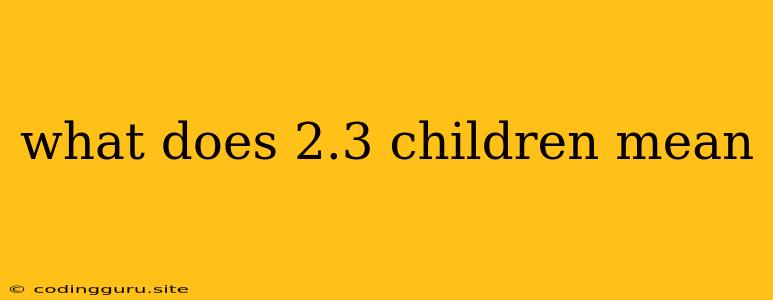What Does "2.3 Children" Mean?
The phrase "2.3 children" might sound strange at first. After all, how can you have a fraction of a child? This seemingly odd phrase is actually a way to express a population statistic, specifically the average number of children per family in a given region or country.
Why Use a Decimal?
The reason we use decimals to represent the average number of children is because not every family has the same number of children. Some families have no children, some have one, some have two, some have three or more, and some even have none. To get a representative figure for the whole population, we average out the number of children per family, which often results in a decimal number.
Calculating the Average
To illustrate this, let's imagine a small town with 10 families:
- Family 1: 2 children
- Family 2: 3 children
- Family 3: 1 child
- Family 4: 0 children
- Family 5: 2 children
- Family 6: 4 children
- Family 7: 2 children
- Family 8: 1 child
- Family 9: 3 children
- Family 10: 2 children
To calculate the average number of children, we add up the total number of children (2 + 3 + 1 + 0 + 2 + 4 + 2 + 1 + 3 + 2 = 20) and then divide by the number of families (10). This gives us an average of 20 / 10 = 2 children per family.
However, if we had a family with twins, the average would become 21/10 = 2.1 children per family. This is where the decimal comes in. It allows us to represent a more accurate picture of the population's childbearing patterns, even though it might seem counterintuitive.
What Does 2.3 Children Really Mean?
So, what does a figure like "2.3 children" actually tell us? It doesn't mean that anyone has 2.3 children. Instead, it means that on average, families in that region have slightly more than two children.
This number can fluctuate based on various factors such as:
- Age distribution of the population: A population with a higher proportion of young adults will likely have a higher birth rate and thus a higher average number of children.
- Cultural norms and societal expectations: Some cultures encourage larger families, while others emphasize smaller families.
- Economic conditions: Factors like education, access to healthcare, and job opportunities can influence the decision to have children and the number of children people have.
Importance of the Statistic
The average number of children per family is a key statistic for demographic studies, as it helps us understand:
- Population growth: A higher average number of children indicates potential future population growth.
- Age structure: The number of children influences the age structure of a population.
- Economic and social implications: The average number of children can impact education, healthcare, housing, and other societal needs.
Conclusion
While "2.3 children" might seem like an odd phrase, it is a simple way to express a complex demographic reality. It reflects the average number of children per family and provides valuable insights into population trends, societal dynamics, and future projections.
